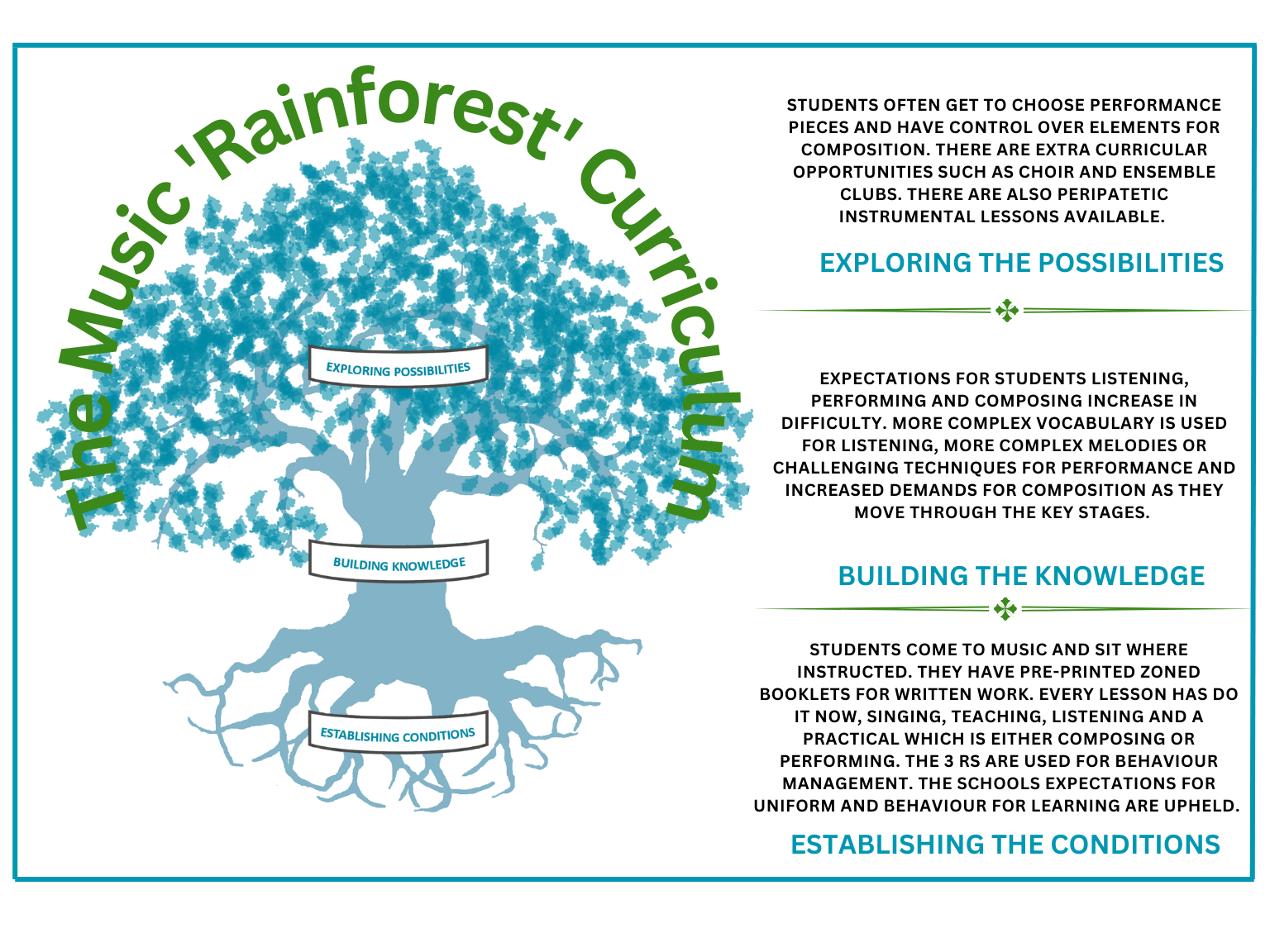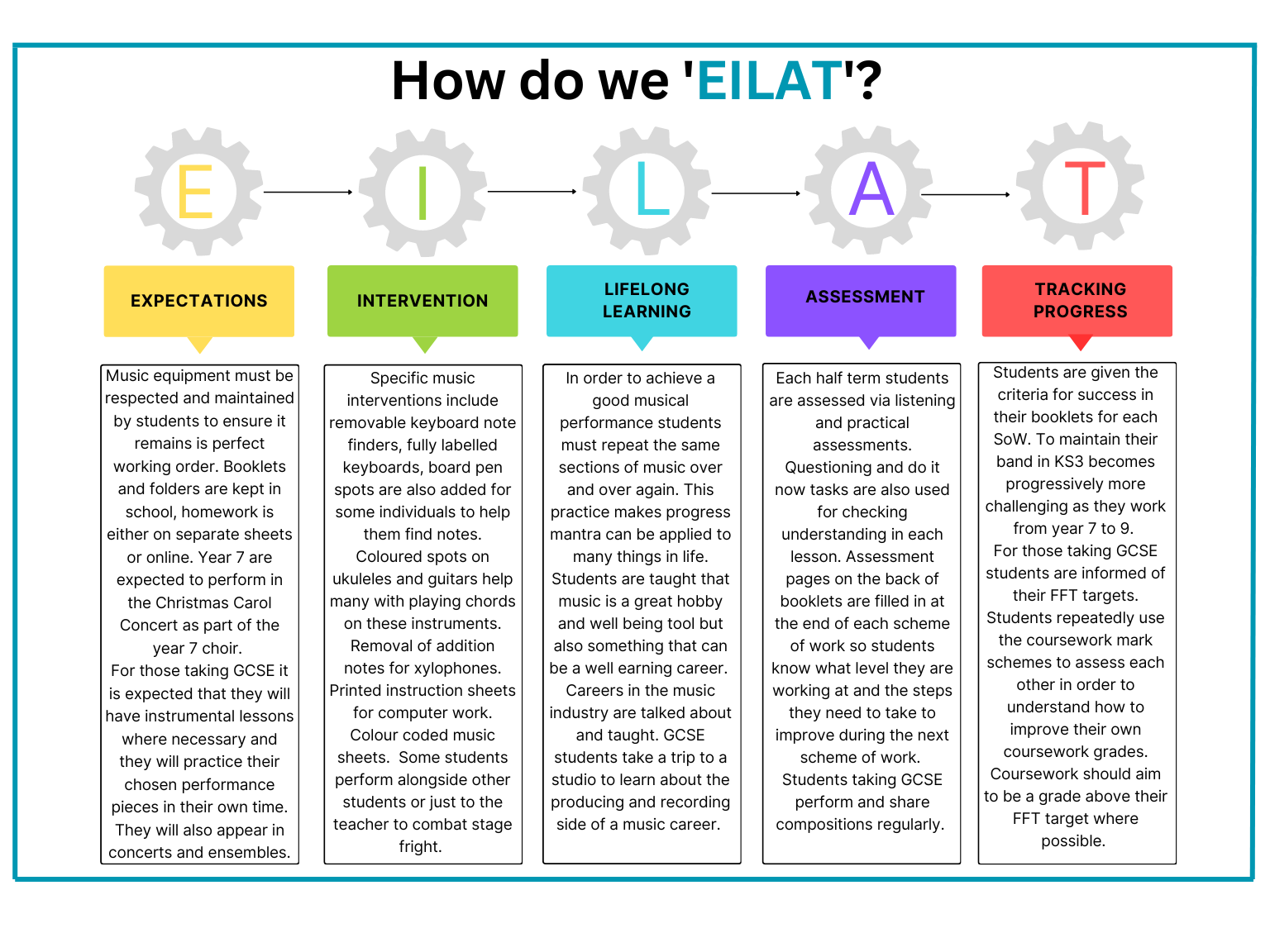Music
'Music gives a soul to the universe, wings to the mind, flight to the imagination and life to everything' - Plato
Intent
At Jubilee High School Music is a cross curricular extravaganza where students learn elements of other subjects whilst becoming confident musicians who perform, listen and compose during exciting and practical music experiences in and out of class.
- Provide students with the means to perform confidently in a range of styles using their voices and a variety of instruments on their own and as part of an ensemble.
- Expose students to a range of listening material to widen their understanding of music history and it’s influences on culture.
- Equip students with the skills and knowledge they need to express themselves through compositions.
- Build confidence in all student’s musical skills to stretch and challenge their musical experience.

Meta-concepts
The following meta-concepts underpin our curriculum:
- Pitch: Learning to listen for, play and compose using the full range of instrument ability.
- Duration: How long notes are.
- Music: Notation: How we write music to remember and read it.
- Texture: How layers of music are built up to create pieces.
- Timbre: The quality of music sound.
- Structure: How sections of music are developed to create whole pieces.
- Tempo: How fast music is played.
- Dynamics: How loud music is played.
Implementation
Key Stage 3
In KS3 students have 1 hour a week lesson time. Every lesson includes do it now, singing, zoned listening, learning and zoned practical which is either composing or performing. Every SoW has cross curricular links. All students are assessed on both listening and practical regularly.
Year 7- In year 7 students begin by focussing on rhythm then add pitch to form melodies on labelled instruments. They are also introduced to musical language via listening tasks. In their second half term they focus on singing and have the opportunity to perform in the annual Carol Concert. In term two they’re introduced to keyboards through studying Renaissance music before focussing on the interrelated dimensions of music during the theory scheme of work. This topic is loosely based on the ABRSM grade 1 theory syllabus. Students concentrate on stave notation and accompanying tempo and dynamics terms, signs and symbols. Having gained this grasp of basic music concepts they use them to compose short jingles. They use ukuleles for this topic and are taught tab notation to play 4 chords C, Am, F and G. We finish the year continuing to use ukuleles and guitars whilst studying 12 bar blues structure. This topic acts as a link and bridge between the Africa topic they begin year 7 with and the Ragtime topic they start with in year 8.
Year 8- In year 8 students develop each instrumental skill: They use keyboards to play Ragtime music which is more complex than the Renaissance pieces due to having syncopated rhythms and chromatic sections. They develop their voice control by singing in harmony. They develop their understanding of how music represents culture during the British topic. They then embark on a theory scheme of work loosely based on the demands of ABRSM grade two. They explore stave notation and more advanced tempo and dynamics terms, signs and symbols. In their last term they develop their composition skills by using Logic Pro on the Apple Macs to experiment with timbres and textures. Lastly, they develop their ukuleles and guitar skills by learning to read tab notation and play additional chords Dm and Bb and notes of the F major scale.
Year 9- In year 9 students advance their instrumental and composing skills. This starts with ensemble work where they not need to use their performance skills in conjunction with other performers which requires an awareness of tempo and dynamic balance. In year 9 singing focusses on the variety of textures found in musical theatre. This singing involves a larger range but more expression. They return to keyboard work whilst studying orchestral music where the students need to play with both left and right hands simultaneously. Rock n Roll follows from the previously studied Blues and Ragtime topics. Students can choose to specialise in an instrument of their choice whilst learning about typical rock song structure. Students return to composition towards the end of the year but this time composing for TV with a piece that conveys the action in the chosen clip. Lastly students begin a performance piece that could be used for their GCSE whilst studying the greatest famous musicians of all time.
Key Stage 4
At KS4 students have 3 hours a week lesson time. Every lesson includes do it now, singing, zoned listening, learning and zoned practical which is either composing or performing.
Year 10 and 11- Students follow the Eduqas music GCSE specification which has 4 areas of study, Musical forms and devices which encompasses music of the Western Classical Tradition, Music for ensemble which encompasses chamber music, jazz and musical theatre, Film Music and Pop music which includes Rock n Pop, Blues, Bhangra and Fusion music. In year 11 they have to produce a minimum of 4 pieces of coursework. Two performances of which one must be ensemble and two compositions of which one must be a response to a brief set by the exam board.

Impact
Music aims to ensure that students enjoy and value Music. The subject aims to have the following impacts on the students at Jubilee High School:
- They understand that while Music lessons enjoyable it is an important part of our heritage and culture.
- The curriculum is designed to allow students who are unable to have 121 instrumental tuition to develop skills to allow them to succeed at the GCSE. Students enjoy taking part in productions and concerts and many develop a thirst for performing which they quench in and out of school. Students from JHS have gone on to complete music A levels, degrees and take up jobs in the music industry.



